|
USS WOLVERINE (IX-64) |
 |
| Displacement:
7,200 tons |
| Length: 500 ft |
|
Beam: 98 ft |
|
Flight deck: 550 ft x 58.3 ft (oak wood
plank) |
| Height: 23.75 ft |
|
Draft: 15.5 ft |
| Propulsion:
(6) single-ended and
(3) double-ended coal-fired Scotch boilers, 165
psi. Inclined 3-cylinder
compound steam
engine, 66", 96", 96" dia. pistons with 108" stroke. (2) side paddlewheels,
32-ft dia. w/ 11 blades, abt. 100-tons
each. |
| Installed power: 12,000
ihp (8,900 kW) @ 31 rpm |
|
Speed: 19 kts (22 mph) |
| Complement: 270 men
(US Navy) |
|
The USS Wolverine (IX-64) was converted
from an old side paddlewheel excursion
steamer "Seeandbee"
by the US Navy. The inland passenger steamer
was originally launched in
1912 and served the Cleveland and Buffalo Transit Co. on the
Great Lakes for nearly 30 years.
At the outbreak of WWII, the US Navy
acquired the Seeandbee, and it was converted
and repurposed as a training aircraft
carrier in 1942, to qualify young naval
aviators for carrier landings and take-offs.
Due to the war's initial shortage of
aircraft carriers and the off-shore threat
of German U-boats, the US Navy created two
makeshift carriers for training new pilots
in the submarine-free waters of Lake
Michigan. The 9th Naval District spearheaded
the plan and operation, which resulted in
the commissioning of the USS Wolverine
(IX-64) and USS Sable (IX-81) in 1942 and
1943 respectively.
Both flattops maintained their original
propulsion systems as coal-fired steamers
driven by twin side-paddlewheels.
The Navy decommissioned USS Wolverine
(IX-64) in 1945 and sold it for scrap in 1947.
|
Old Newsreels
|
|
|
|
|
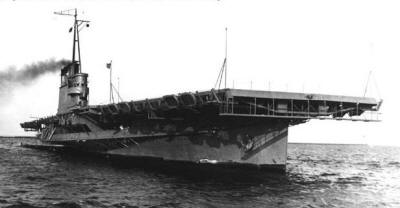 |
| USS
Wolverine (IX-64) underway in Chicago harbor, 22 August
1942. Along with having side paddle wheel propulsion, the
USS Wolverine and USS Sable training carriers used
coal-fired boilers to power their mighty steam engines rated
at 12,000 ihp. |
| |
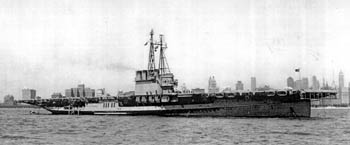 |
|
USS
Wolverine (IX-64) lying at anchor with Chicago skyline
beyond. |
| |
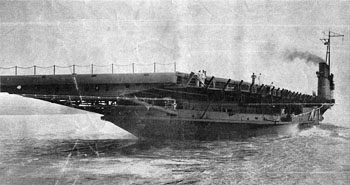 |
|
Stern end of the newly commissioned USS Wolverine (IX-64) training
carrier in 1942. Naval aviators used these to become
carrier qualified. |
| |
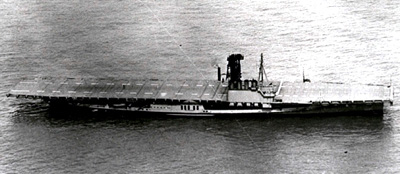 |
| USS Wolverine (IX-64) lying at anchor on Lake
Michigan near Chicago showing starboard side, 06
April 1943. A collier is alongside with coal
hoisting gear to refuel the training carrier, on
Lake Michigan. |
|
|
|
Naval Service
|
|
In 1941, prior to the beginning of World War II, the need
to be able to train pilots in aircraft carrier takeoffs and
landings became an area of concern. There were a limited
number of aircraft carriers available and these were
assigned to front line duties. Commander Richard F.
Whitehead made the initial proposal of converting lake
steamers into training aircraft carriers but his idea was
met with little interest. Following the Japanese attack on
Pearl Harbor his proposal was fast tracked by Admiral Ernest
J. King Chief of Naval Operations. The option of using a
lake steamer decided upon for a number of reasons including
that a new ship wouldn't have to be built scratch which
would free up resources for other ship production and that a
suitable size ocean vessel or an existing aircraft carrier
were too wide to fit through the Welland Canal.
|
|
|
|
|
|
|
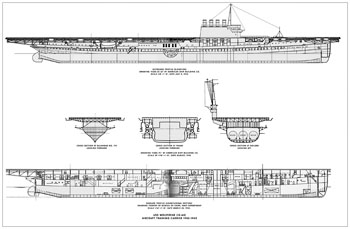 |
|
Drawings of aircraft training carrier USS Wolverine.
Original drawings by American Ship Building Company
from 1942. Touchup in 2018 by Stacy. |
|
|
Refit
|
|
The Navy acquired Seeandbee from the C&B Transit Company
on 12 March 1942 for the price of $756,500 and designated
her an unclassified miscellaneous auxiliary vessel IX-64.
Seeandbee's existing superstructure was removed at
Cleveland, Ohio and the ship was towed to Buffalo to undergo
refitting by the American Shipbuilding Company. From 6 May
1942 a 550 ft long wooden flight deck was installed, a new
bridge island was built, arresting cables installed, the
funnels rerouted to the starboard side of the ship along
with other modification. Unable to fit in a dry dock due to
its size, the refit was done while the ship was afloat. At
its peak a crew of 1,250 men worked round the clock and it
was reported that 45 miles of welding as well as 57,000
bolts with washers and grommets were used during the refit
operations. A Coast Guard substation was set up to provide
security for the work and no pedestrians or vehicles were
allowed near the work site.
The name Wolverine was approved on 2 August 1942 with the
ship being commissioned on 12 August 1942 at Buffalo, New
York with Commander G. R. Fairlamb in command. The
commissioning ceremony was closed to the public and was
attended by only certain dignitaries, the new crew and
roughly five hundred workmen who were still on board.
Intended to operate on Lake Michigan, IX-64 received her
name because the state of Michigan is known as the Wolverine
State.
|
|
|
|
|
|
|
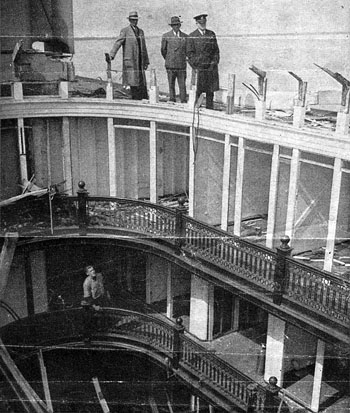 |
|
Seeandbee's elaborate atrium and staterooms all
being stripped during steamer's conversion to US
Navy training carrier USS Wolverine. |
|
|
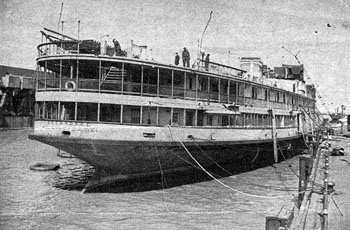 |
|
Seeandbee tied to dock at shipyard in Buffalo,
NY, where 30-year-old excursion steamer was stripped
bare before flight deck was added. |
|
|
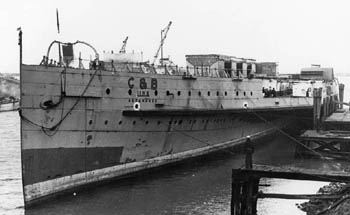 |
|
Seeandbee
undergoing conversion to training carrier is stripped of her
superstructure down to her gunwales at American Ship
Building Co. yard in Buffalo, New York.
Circa. May 1942 |
|
|
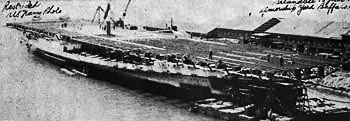 |
|
Another view of Seeandbee conversion to
Wolverine (bow to right), showing steel framing of
carrier's deck. - US Navy
photo, 15 June 42 |
|
|
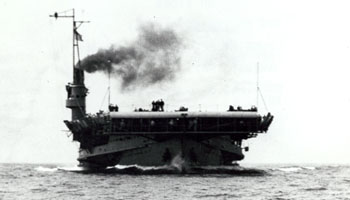 |
USS Wolverine undergoing official trials near
Buffalo, New York.
National Naval Aviation Museum photo - 11 Aug 1942 |
|
|
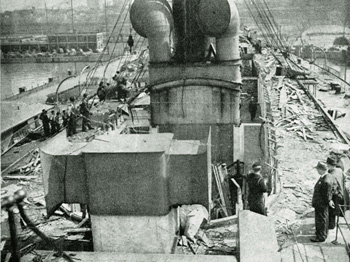 |
|
The former
Great Lakes steamer Seeandbee, looking desolate, as wrecking crews begin
to strip her bare to the gunwales in Cleveland, Ohio in summer of 1942. Visible
are the two intakes in front of smoke stack atop a boiler
uptake casing (one of four). The hull was towed to Buffalo,
NY for
conversion where it was transformed into an aircraft carrier. |
|
|
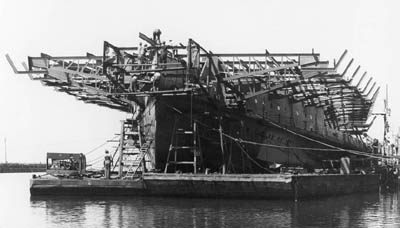 |
Looking
more like a carrier, Seeandbee's conversion to USS Wolverine
(IX-64) shown on 12 June 1942. The Navy acquired the
side-wheel steamer on 12 Mar 1942 and designated her an
unclassified miscellaneous auxiliary ship, IX-64; conversion
began on 6 May 1942.
Naval History &
Heritage Command photo |
|
|
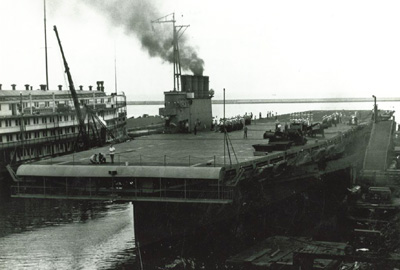 |
USS Wolverine
(IX-64) moored at Buffalo, NY, probably taken during its
commissioning on 12 Aug 1942. To its left is
steamer Greater Buffalo, just beginning its conversion to USS Sable
(IX-81).
National Naval Aviation
Museum photo - 12 Aug 1942 |
|
|
Assignment
|
|
Wolverine began her new assignment in January 1943
stationed at Chicago, Illinois at what came to be called
Navy Pier, assigned to the 9th Naval District Carrier
Qualification Training Unit. Her sister ship, USS Sable,
joined Wolverine in May 1943 and the two ships began to be
casually referred to as the "Corn Belt Fleet". By 7 May 1943
it was reported that the 7,000th successful landing had been
made on Wolverine.
In conjunction with NAS Glenview, the two paddle-wheelers
afforded critical training in basic carrier operations to
thousands of pilots and also to smaller numbers of Landing
Signal Officers (LSOs). Wolverine and Sable enabled the
pilots and LSOs to learn to handle take-offs and landings on
a real flight deck. Sable and Wolverine were a far cry from
front-line carriers, but they accomplished the Navy's
purpose: qualifying naval aviators fresh from operational
flight training in carrier landings.
Problems
Wolverine and Sable were not true aircraft carriers and
they had certain limitations. One was that there were no
elevators or hangar decks to store damaged aircraft. If all
the storage spaces on the flight deck were filled with
damaged aircraft, the day's operations were over and the
carriers headed back to their pier in Chicago.
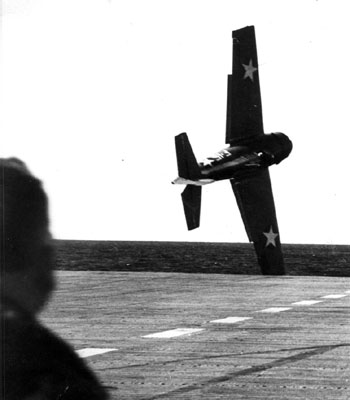 Landing
aircraft on calm days became another problem for the
carriers. Both carriers couldn't generate sufficient speed
to meet the "wind over deck" (WOD) landing minimums for
aircraft such as F6F Hellcats, F4U Corsairs, TBM Avengers
and SBD Dauntlesses. When there was little or no wind on
Lake Michigan, operations often had to be curtailed. Landing
aircraft on calm days became another problem for the
carriers. Both carriers couldn't generate sufficient speed
to meet the "wind over deck" (WOD) landing minimums for
aircraft such as F6F Hellcats, F4U Corsairs, TBM Avengers
and SBD Dauntlesses. When there was little or no wind on
Lake Michigan, operations often had to be curtailed.
Occasionally, when low-wind conditions persisted for
several days and the pool of waiting aviators started to
bunch up, the Navy turned to an alternate system of
qualifications. The pilots qualified in SNJ Texans - even
though most pilots had last flown the SNJ four or five
months earlier.
|
Operational Timeline of USS Wolverine
(IX-64)
|
|
02 Mar 1942 |
US Navy acquired excursion
steamer Seeandbee. |
|
02 Aug 1942 |
US Navy approved the new name
Wolverine for the fresh water
aircraft carrier recently converted
from excursion steamer Seeandbee. |
|
12 Aug 1942 |
USS Wolverine commissioned
into service with CDR. George
Richardson Fairlamb, Jr. in command. |
|
07 Nov 1945 |
USS Wolverine was decommissioned
from service. |
|
28 Nov 1945 |
Wolverine struck from the US
Naval Vessel Register. |
|
26 Nov 1947 |
Wolverine transferred to Maritime Commission for disposal. |
|
Commanding Officers of USS Wolverine (IX-64)
|
| i. |
|
CDR. Fairlamb Jr., George
R., USN |
|
Aug 1942 |
- |
Dec 1942 |
| ii. |
|
CDR. Bowman, Roscoe Leroy, USN |
|
Dec 1942 |
- |
Jan 1943 |
| iii. |
|
CPT. Lee, Charles Loomis, USN |
|
Jan 1943 |
- |
May 1944 |
| iv. |
|
CPT. DeWolfe, Robert Rathbun, USN |
|
May 1944 |
- |
Jun 1944 |
| v. |
|
CDR. Rigg, James Francis, USN |
|
Jun 1944 |
- |
Nov 1944 |
| vi. |
|
CDR. Wigfall, George H.,
USN |
|
Nov 1944 |
- |
Nov
1945 |
|
|
|
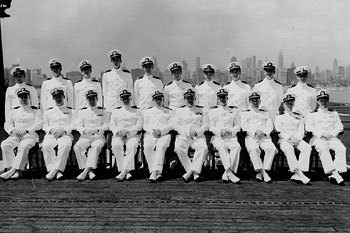 |
|
Officers aboard USS Wolverine (IX-64) with
Chicago skyline (Jul 1944) |
|
|
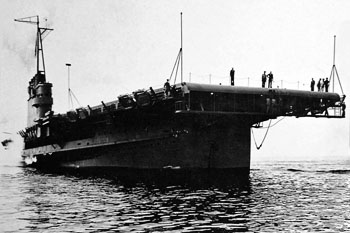 |
|
|
|
|
|
|
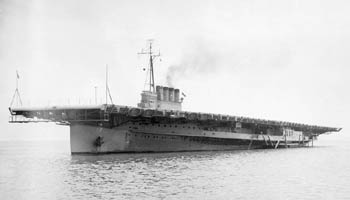 |
|
The
USS Wolverine (IX-64) was one of two refitted coal-fired,
side paddlewheel passenger steamers converted into training
carriers, which operated on Lake Michigan. Shown here shortly
after her conversion from Great Lakes passenger liner
Seeandbee. When at anchor, Wolverine would raise her radio
masts, as witnessed by the two masts on her bow round-down.
Two thirds of the way down each side are the paddlewheel
boxes which propelled the training carrier. |
|
Naval History & Heritage
Command photo - ca. 1942 |
|
|
|
|
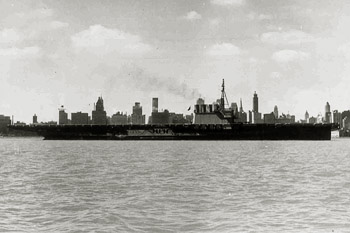 |
|
Wolverine in front of the Chicago skyline on
Mar 22, 1943, shortly after beginning her
assignment. |
|
|
|
|
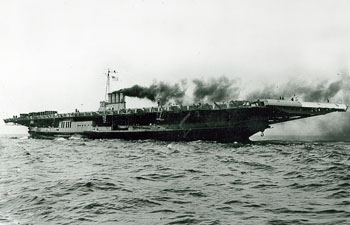 |
|
USS Wolverine (IX-64)
emitting black soot from her coal-fired
boilers while underway on Lake
Michigan in 1943. |
|
|
|
|
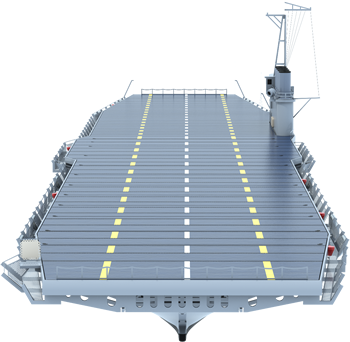 |
|
A CAD 3D rendering of USS Wolverine IX-64 and
its ramp, which is the beginning of the
flight deck at the stern of the carrier.
This view is similar to that
seen by naval air cadets attempting to land
their planes during carrier qualification
training. These training carrier exercises
took place on Lake Michigan between 1942 and
1945. |
|
|
|
|
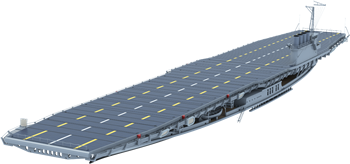 |
|
|
|
CAD 3D rendering showing Wolverine's stern
end and starboard side. |
|
|
End of Service
|
|
Once the war was over, the need for such training ships
also came to an end. The Navy decommissioned Wolverine on 7
November 1945; three weeks later, on 28 November, she was
struck from the Naval Vessel Register.
USS Wolverine (IX-64) was then
transferred to the War Shipping
Administration on 14 November 1945. The ship
was offered to U.S. citizens for either U.S.
flag operation or scrapping and sold 21
November 1947 to A. F. Wagner Iron Works of
Milwaukee, Wisconsin for $46,789 to be
scrapped.
Its sister ship, USS
Sable (IX-81), was also decommissioned about same time and sold for scrap.
|
|
|
|
|
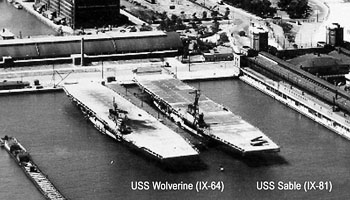 |
|
Both aircraft training carriers backed into
dock at Chicago's Navy Pier. Decommissioned after the war
in 1945, and later sold for scrap in
1947. |
|
|
Flight deck operations on USS Wolverine from 1942-1945
|
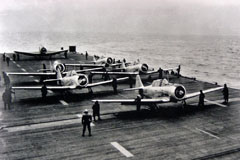 |
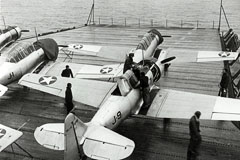 |
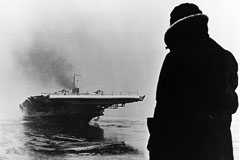 |
|
NAA
SNJ Texans running on deck of Wolverine |
SNJ Texans parked on Wolverine's flight deck |
View of
USS Wolverine aircraft training carrier |
|
|
|
|
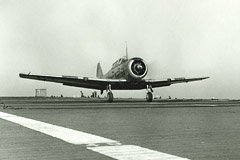 |
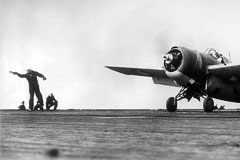 |
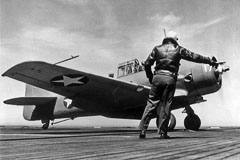 |
|
NAA
SNJ-3 on Wolverine's oak plank flight deck |
F4F/FM Wildcat launch |
North American Aviation SNJ-3c Texan launch |
|
|
|
|
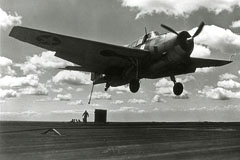 |
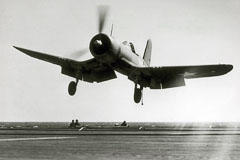 |
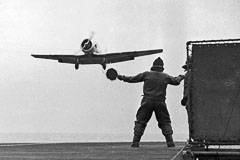 |
| TBF/TBM Avenger recovery |
F4U-1 Corsair is recovered |
SNJ guided by the Landing Signal Officer (LSO) |
|
|
|
|
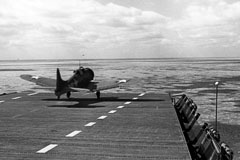 |
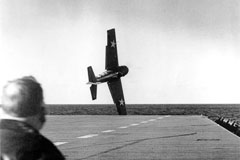 |
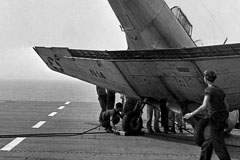 |
| Douglas SBD Dauntless launch |
Grumman F4F-4 Wildcat mishap |
NAA SNJ nose over into barrier |
| |
|
|
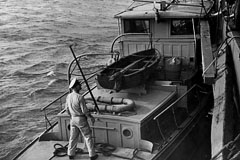 |
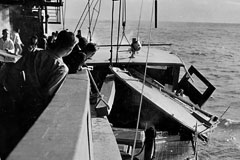 |
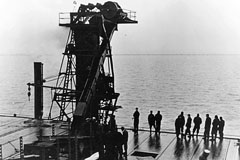 |
| Plane guard boat collides with Wolverine |
Plane guard boat collides with Wolverine |
USS Wolverine coal refueling by collier
alongside |
|
|
|
|
|
| |
|
History of Vessel
|
 |
|
Name: SEEANDBEE, (aka USS
Wolverine, 1942) |
|
Build Year: 1913 |
|
Official Number: US211085 |
|
Type: Inland (Great Lakes)
passenger steamer |
|
No. of Decks: 5 |
|
Builder: Detroit Shipbuilding Co.,
Wyandotte, MI |
|
Owner: Cleveland and Buffalo
Transit Co., Cleveland, OH |
|
Hull Materials: Steel |
|
Hull No.:
190 |
|
Propulsion Type: Side-wheel |
|
Power: 3 cylinders, 9 boilers |
|
Length: 485' |
|
Beam: 58' |
|
Depth: 23'-6" |
|
Tonnage Gross: 6381 |
|
Tonnage Net: 3434 |
|
Launched: 09 Nov 1912 |
|
|
Acquired
by US Navy: 02 Mar 1942 |
|
Conversion: American Ship Building
Co. yard in Buffalo, NY |
|
Renamed:
USS Wolverine (IX-64) on
02 Aug 1942 |
|
Commissioned: 12 Aug 1942 at
Buffalo, NY |
|
Decommissioned: 07 Nov 1945 |
|
Stricken: 28 Nov 1945 |
|
Final Disposition: Milwaukee, WI
Lake Michigan, 21 Nov 1947, sold for scrapping. |
|
Other Facts:
Named in contest as acronym for C & B Line. Largest
passenger ship when launched. Only four stacker ever
to sail Great Lakes. Too big for Soo Locks & Welland
Canal; confined to Lakes Erie, Huron & Michigan. |
|
1939 |
|
Leased Cleveland &
Buffalo Steamship Company, Chicago, Illinois. |
|
1941 |
|
Owned Cleveland &
Buffalo Steamship Company. |
|
1942 |
|
Acquired by U.S. Navy,
Washington, D.C. and renamed USS WOLVERINE (IX-64);
stripped to deck at Cleveland, Ohio. Converted to
training aircraft carrier at Buffalo, NY, with deck
103' wide x 550' long. |
|
1942-46 |
|
Operated
out of Chicago with planes based at Glenview Naval
Air Station; over 70,000 landings & take-offs. |
|
1947 |
|
Owned A.F. Wagner Iron
Works, Milwaukee, Wisconsin; scrapped. |
|
|
|
|
|
|
|
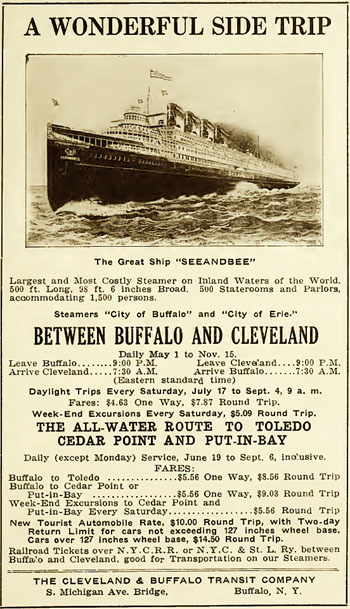 |
|
|
|
|
|
|
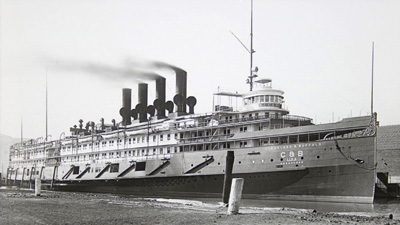 |
| The Great Lakes passenger
streamer Seeandbee, as-built for the Cleveland and Buffalo Transit
Company (C & B Line), is moored pierside in August 1919. |
|
Design and Construction of Seeandbee
Seeandbee, intended for overnight passenger service
between Cleveland and Buffalo, was designed by naval
architect Frank E. Kirby for the Cleveland and Buffalo
Transit Company (C&B) of Cleveland, Ohio. Two basic features
were utilized in the ship's design as an overnight, luxury
passenger service for those wanting a good night's sleep.
Side-wheel paddle propulsion was selected because it allowed
more area over the paddle boxes for cabins and decks, also
it increased maneuverability and stability in rough weather
over screw-type propellers. Secondly, the more expensive and
much heavier compound inclined steam engine was chosen due
to its ability to develop 12,000 horsepower at low
revolutions (about 30 rpms) without the vibration associated
with the higher revolutions required by lighter vertical
types for similar power.
The ship (hull no. 190) was built by the Detroit Shipbuilding Company,
soon to be acquired and renamed American Ship Building
Company, of Wyandotte, Michigan. Seeandbee, the largest
side-wheel steamer in the world at the time, was launched
November 9, 1912. According to the Interstate Commerce
Commission the ship's tonnage (displacement) was 6,381 GRT
and 1,500 DWT.
|
Hull Engineering
The ship's dimensions as built were 500'-0" length
overall, 485'-0" between perpendiculars, 58'-0" molded hull
beam, 97'-8" extreme beam over guards with extreme depth of
hull at stem being 30'-4" and 23'-6" molded depth. The hull
was entirely steel with a double bottom extending almost
365' feet containing water ballast and divided lengthwise
with a watertight bulkhead and by transverse bulkheads into
fourteen compartments. Above that 3'-0" ballast compartment
the ship was divided by eleven watertight bulkheads
extending from keel to main deck with hydraulic doors
operated from the engine room. In total there were seven
decks: tank top, orlop, main, promenade, gallery, upper and
dome. Steel was used to the promenade deck with fire
protection for beams above that level and fireproof doors
provided compartmentalization and steel fire curtains in
cargo spaces. For fire alarm purposes the vessel was divided
into fifty sections with fire hydrants spaced so that
permanently attached hoses reached every point in the vessel
and an extensive sprinkler system.
|
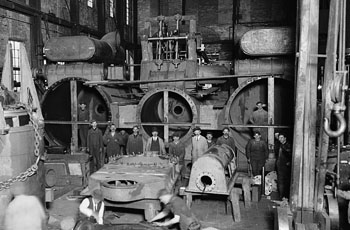 |
Seeandbee's main engine in shop, 3-cylinder compound-inclined type
66" x 96" x 96" / 108" (bores/stroke). Two men are standing inside each
8 ft dia. cyl. bore. The steam engine rated at 31 rpm, takes 1.03
seconds for each piston to travel the 9 ft stroke.
Library of Congress
photo - ca Oct 1912 |
|
|
Propulsion was by an inclined, three cylinder steam
engine below the main deck with only the main bearing tops,
upper parts of the valves and handling levers above the main
deck. The engine was unique in using a Walschaert gear,
normally used on locomotives, to drive a Corliss gear for
the two low pressure cylinders and the poppet type valves on
the high pressure portion. The speed guarantee of 22 miles
per hour was met by the engine's indicated horsepower of
12,000 ihp (8,900 kW) at 31 revolutions per minute. The high
pressure cylinder, 66 in. (5'-6") in diameter, was centered
between the two low pressure cylinders of 96 in. (8'-0")
diameter with steam provided by six single-ended and three
double-ended Scotch boilers forward of the engine room
delivering steam at 165 pounds per square inch. The single
ended boilers were 14'-0" inside diameter by 10'-6" length,
and the double-ended boilers were 14'-2 3/16" mean diameter
by 20'-5 1/2" length.
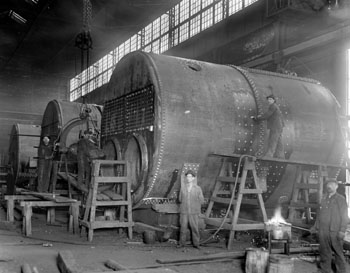 |
Seeandbee's three double-ended coal-fired Scotch marine boilers inside D.S.Co.'s
fabrication shop. Each boiler measures 14'-0" diameter by
21'-10" long. Six single-ended boilers
were also fabricated for the ship.
Library of Congress
photo - Oct 26, 1912 |
The two 32'-9" diameter paddle wheels
each had eleven steel buckets 14'-10" long by 5'-0" wide.
Due to the restricted channels at both Cleveland and Buffalo
additional maneuvering capability was required and a bow
rudder and steam steering engine were provided.
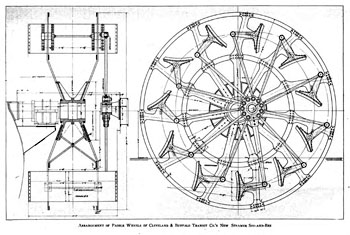 |
| Arrangement of Paddle Wheels of
Cleveland & Buffalo Transit Co.'s new
steamer Seeandbee. Nov
1912. The Marine Review. p 369. |
Seeandbee's Accommodations
Passengers were accommodated in 510 rooms of which 424
were regulation, 62 were fitted with private toilets and 24
were "parlors en suite" giving sleeping room for 1,500
persons and capable of carrying a total of 6,000 passengers
and 1,500 tons of cargo loaded on the main deck. Passengers
boarded through a mahogany paneled lobby with a Tuscan theme
having steward's and purser's offices, telephone booths and
a stairway to the promenade deck protected by a vestibule
with sliding doors. Aft, extending to the stern, was the
main dining room paneled in mahogany and white enamel with a
banquet room on the starboard side and two private dining
rooms to port. Alcoves with bay windows provided some
relatively private dining areas in the main dining room.
Stairs led to a buffet of old English tavern decor below the
dining room.
|
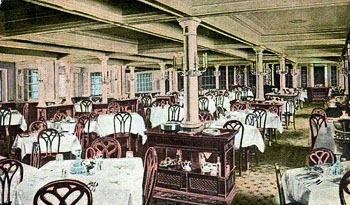 |
|
A feature of the vessel was the main saloon on the
promenade deck that extended almost 400 ft (121.9 m) in
length subdivided into sections with a book shop, flower
booths, observation room and men's and ladies writing rooms.
A number of private parlors, each of different design
containing beds and private baths and balconies, were set
off the main saloon and aft, in an arrangement designed so
that it could be heard both in the saloon and above in the
atrium and ladies drawing room, was a balcony for an
orchestra. On the gallery deck was the ladies drawing room
in Italian Renaissance style with built in seats and above,
on the next deck, was an Atrium with sleeping rooms
adjoining. Amidships on the gallery deck was the lounge with
seating and provision for light refreshments.
Washed air ventilation units provided fresh air for all
interior spaces with exhaust fans for removal of foul air.
Three steam turbines drove generator sets for electricity
for 4,500 electric lights, including the largest searchlight
32 inches on the Great Lakes, and the ship was extensively
electrified for auxiliary functions. Over 500 telephones
were aboard with one in every stateroom, officer's quarters
and in booths in passenger areas as part of a public system
and a private system for use in ship operations.
Commercial Operation
Seeandbee carried members of the Cleveland Chamber of
Commerce to Buffalo on the maiden voyage with regular
operations beginning from the East 9th Street pier in 1913.
In addition to the scheduled operation between Cleveland and
Buffalo the vessel made special cruises to Detroit and
Chicago and in summer. Due to heavy losses in 1938 Cleveland
and Buffalo Transit was liquidated in 1939 with the vessel
acquired by the Chicago based C&B Transit Company that
operated the ship through 1941.
|
|
|
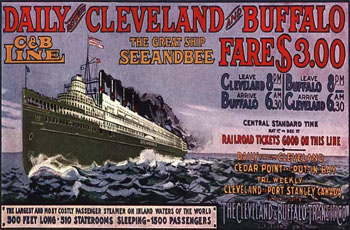 |
| In its day, Seeandbee was the largest
and most costly passenger steamer on inland
waters of the world. It was 500 feet
long, had 510 staterooms with sleeping
accommodations for 1,500 passengers. |
|
|
|
|
|
|
|
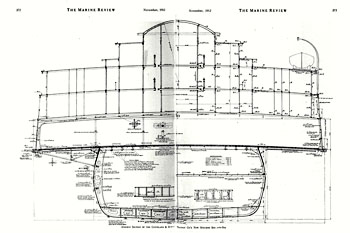 |
| Line drawing showing Midship Section the Cleveland and Buffalo
Transit Co.'s new steamer Seeandbee. (Nov 1912).
The Marine Review |
| |
| |
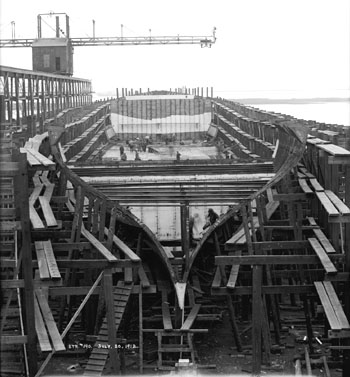 |
The steam ship Seeandbee (hull no. 190) is under construction at the
Detroit Shipbuilding Company's yard in Wyandotte, Michigan.
Library of Congress
photo - Jul 20, 1912 |
| |
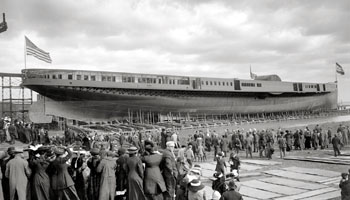 |
Starboard side with hull on the ways during ship's launch ceremony.
The steamer's two rounded side-paddlewheel boxes are located midship.
Library of Congress
photo - Nov 9, 1912 |
| |
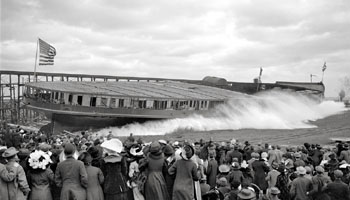 |
A large crowd gathers as Seeandbee is launched at Wyandotte,
Michigan before crews begin work on the superstructure.
Library of Congress
photo - Nov 9, 1912 |
| |
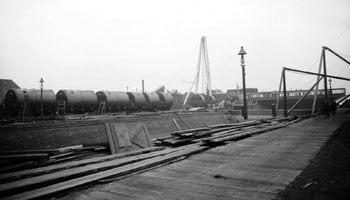 |
Complete battery of boilers for steamer Seeandbee, as hoisting
aboard ship begins. From left are 3 double-ended boilers, 3
single-ended, with three more single boilers below the A-frame derrick
in middle
Library of Congress
photo - Nov 23, 1912 |
| |
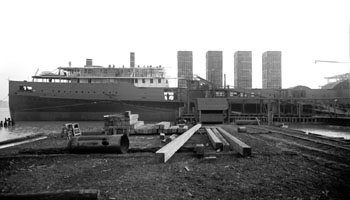 |
Seeandbee's port side with its four boiler uptake casings towering
above and upon which the funnels and intakes will sit.
Library of Congress photo - Dec 07, 1912 |
| |
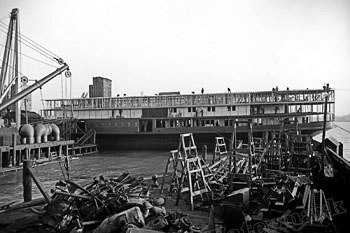 |
Seeandbee's port side and stern in Detroit Shipbuilding Co.'s, yard.
The ship's intakes are sitting toward left. with its four boiler uptake
casings towering above and upon which the funnels and intakes will sit.
Photo ca. Dec 07, 1912 |
| |
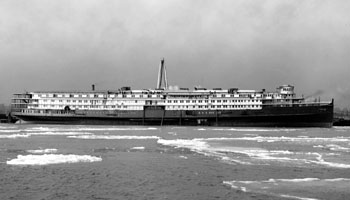 |
| Starboard side showing superstructure nearing completion on icy
waters near Detroit. Library
of Congress photo - Dec 28, 1912 |
| |
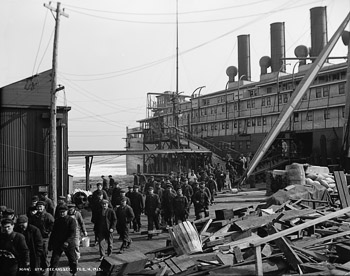 |
| Noon break for crews working on Great Lakes steamer Seeandbee in
ship yard of Detroit Shipbuilding Company on Feb 14, 1913. |
| |
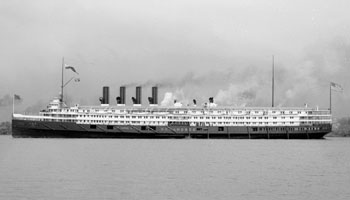 |
Great Lakes steamer Seeandbee underway shortly after its completion.
Library
of Congress photo - May 22, 1913 |
| |
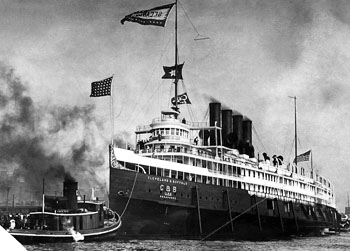 |
| The steamer Seeandbee with harbor tug on its bow,
circa 1920s. |
| |
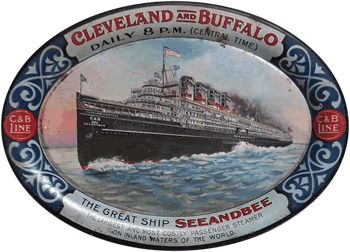 |
| A souvenir metal tray from the great ship Seeandbee. Its namesake
was for the Cleveland and Buffalo (C&B) Line, which ran between the
cities. |
|
|
|
|
|
|
|
|
|
|
| |